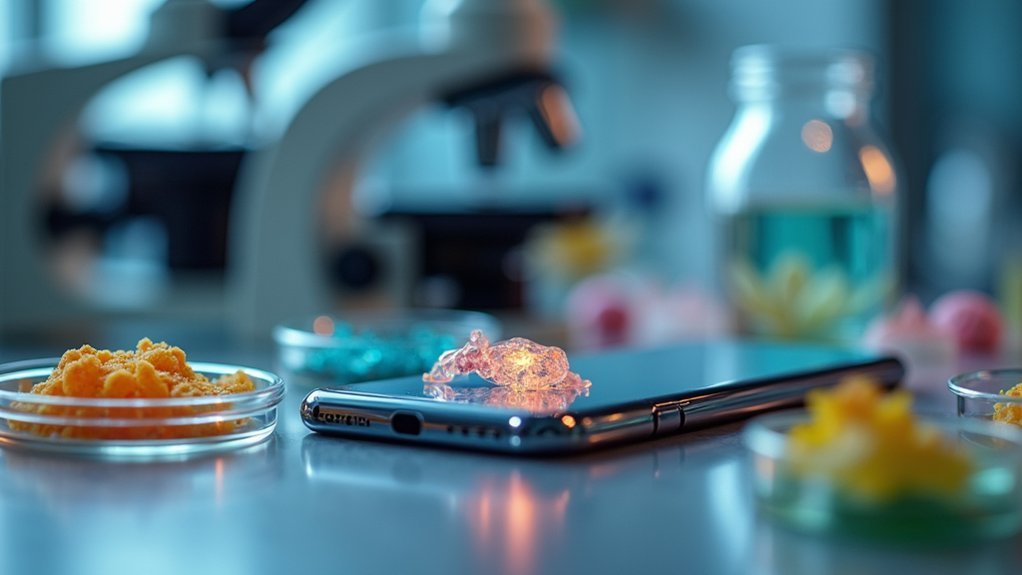Premium phone adapters for scientific photography offer superior stability and alignment capabilities compared to budget options. Look for models compatible with your smartphone’s dimensions (58-110mm width) and microscope eyepiece (19-53mm diameter). The best adapters feature rubber-coated clamps, multi-axis adjustments, and tripod threads for long exposures. Brands like Visionary, Bresser, Celestron, and Altair Astro provide reliable options that minimize shake while ensuring crisp, vignette-free images. Discover how these tools can transform your scientific imaging across multiple instruments.
Top Universal Phone Adapters for Microscope Photography

When capturing microscopic details with your smartphone, the right adapter makes all the difference between blurry approximations and publication-worthy images.
Universal adapters like the Visionary model accommodate ocular lenses from 26mm to 51mm diameter, perfectly aligning your phone camera with the microscope’s optical axis.
The Bresser Universal Smartphone Holder Deluxe uses suction cups for secure positioning on eyepieces between 22mm and 38mm.
For frequent device switching, consider the Celestron NeXGo with its spring-loaded clamps that allow quick shifts between different smartphones.
If stable imaging is your priority, the Altair Astro Self-Centering Smartphone Adaptor minimizes shake with rubber-coated clamping arms.
Many advanced models also feature tripod threads, providing additional stability for long exposure microscope photography when precise documentation is essential.
Key Features to Consider When Choosing a Microscope Phone Adapter
Selecting the right microscope phone adapter requires attention to several critical specifications that directly impact your scientific photography results. You’ll need to prioritize compatibility with both your smartphone model and microscope eyepiece diameter (typically 19-53mm).
| Feature | Importance | What to Look For |
|---|---|---|
| Compatibility | Essential | Fits your phone model and ocular size |
| Adjustable Settings | High | Enables precise alignment with eyepiece |
| Build Quality | High | Rubber-coated clamps for secure grip |
| Additional Features | Medium | Tripod threads for long exposures |
Look for adapters with strong and durable build that can securely hold various smartphone sizes (58-110mm width, 108-200mm height, <15mm thickness). The best models offer adjustable features that reduce shake and enhance image clarity—critical for capturing detailed scientific specimens.
Comparing Premium vs. Budget Microscope Camera Adapters

Three critical distinctions separate premium and budget microscope camera adapters, with each affecting your scientific photography outcomes.
When evaluating options like the Tele Vue FoneMate against the Bresser Universal Holder, you’ll notice premium models deliver superior build quality, ensuring precise alignment and minimizing image shake during essential documentation.
- Premium smartphone camera adapters offer adjustable positioning features, accommodating various devices while providing secure grip for heavier phones up to 300g.
- Budget microscope camera adapters may save you money initially but often lack the stability and versatility needed for serious scientific work.
- Your investment in premium adapters typically includes extended warranties and dedicated customer support, providing long-term value that budget alternatives rarely match.
Consider your photography requirements carefully before choosing between premium durability and budget accessibility.
How Proper Alignment Impacts Image Quality in Microscope Photography
Proper alignment between your smartphone camera and microscope eyepiece forms the foundation of exceptional scientific photography. When your camera lens isn’t perfectly centered over the ocular lens, you’ll notice vignetting—dark corners that compromise image quality and obscure essential photographic detail.
High-quality smartphone adapters provide vital multi-axis adjustments, allowing you to position your device with precision. The distance between your phone and the microscope matters greatly; too far reduces detail capture, while too close creates blurring.
For consistently sharp scientific images, invest in an adapter that maintains stable alignment during use. The best models feature sturdy construction that minimizes camera shake while supporting precise positioning.
Expanding Your Scientific Photography With Multi-Purpose Adapters

While dedicated smartphone-to-microscope adapters excel at one task, multi-purpose adapters greatly expand your scientific imaging capabilities across multiple instruments.
When your adapter comes with 3-axis adjustment features, you’ll achieve accurate leveling and perfect alignment between your smartphone camera and the eyepiece of various optical devices.
- Multi-purpose adapters support diverse applications from astrophotography of celestial objects to detailed wildlife documentation at a distance.
- Your smartphone’s size isn’t a limitation—these versatile tools accommodate devices ranging from 58-110mm in width and 108-200mm in height.
- For scientific imaging requiring longer exposures, look for adapters with tripod threads and remote shutter capabilities to eliminate camera shake.
Frequently Asked Questions
Are Phone Camera Adapters Compatible With Protective Phone Cases?
You’ll find most phone camera adapters work with slim cases, but bulky ones might interfere with proper alignment. For the best fit, you’re better off removing your case when attaching camera adapters.
How Do I Prevent Condensation When Using Adapters in Cold Environments?
To prevent condensation in cold environments, you’ll need to acclimate your equipment gradually. Keep silica gel packets handy, use anti-fog solutions, and store your adapter in a sealed bag when not in use.
Can These Adapters Be Used With Front-Facing Cameras?
Most adapters aren’t designed for front-facing cameras due to their positioning and lower quality. You’ll need specially designed adapters if you’re attempting selfie-style scientific photography. It’s generally better to use the main rear camera.
How Stable Are Adapters During Long-Exposure Scientific Photography?
For long-exposure scientific photography, you’ll need adapters with solid locking mechanisms. Most quality adapters are stable, but tripod mounting is essential to eliminate vibrations that could blur your detailed microscopic or astronomical images.
Do Phone Adapters Affect Microscope Calibration or Measurement Accuracy?
Phone adapters can affect calibration if improperly aligned or introducing weight that shifts the microscope. You’ll need to recalibrate after installation and verify measurements with a stage micrometer to maintain accuracy.
In Summary
You’ll get the most from your scientific photography by investing in a phone adapter that meets your specific needs. Whether you’re choosing a universal microscope adapter or a multi-purpose solution, prioritize stability, alignment flexibility, and compatibility with your devices. Don’t compromise on image quality—the right adapter transforms your smartphone into a powerful scientific documentation tool that’ll enhance your research and observations.





Leave a Reply